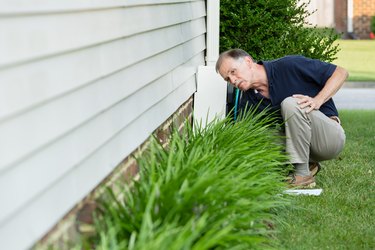
They may look small and harmless — maybe even kind of cute — but mice are wild animals, and they can cause serious damage to your home and property. Mice also transmit pathogens that cause diseases, endangering your family.
One common way mice enter your home is through irregularities in your home's foundation where it meets the siding. You can find gaps and cracks along the siding after inspection. Holes occur over time when seals crack around plumbing fixtures on your siding, allowing mice entrance into your home.
Video of the Day
Video of the Day
By sealing gaps in your walls and siding, you can successfully secure your home from outdoor pests. Inexpensive and simple to do, sealing your siding only requires a little time to locate the cracks.
Things You'll Need
How to Seal Siding to Keep Mice Out
Step 1: Find the Entry Sites
Find the entrances mice use to enter your home. Crawl around the exterior of your home and use a flashlight to find cracks, holes and gaps in your siding.
Step 2: Check the Siding
Look under the siding at the area meeting the foundation of your home for holes and gaps. Use a small mirror to help you see underneath areas.
Step 3: Gauge the Size
Slide a pencil into any hole or crack you find. If you can slide the pencil in, a little mouse can squeeze its body in.
Step 4: Check the Attic and Basement
Go into your basement or attic with the lights off during the daytime. If you see sunlight streaming in, it may come through cracks in the siding. Spiders come through these cracks also, so look for their webs, which may point you to cracks and holes.
Step 5: Gear Up for Safety
Put on your gloves and eye protection, bring a rag for cleaning spills, then visit the cracks and gaps you spotted along your siding.
Step 6: Seal Small Spots
Seal small cracks and gaps in your siding, under 1/4 inch wide, using an acrylic latex caulk. Simply apply this inexpensive into the cracks to seal. Paint works well over it.
Step 7: Caulk Larger Areas
Seal larger gaps, up to 1/2 inch wide, with polyurethane caulk. This is messier than acrylic latex, but effective. Use mineral spirits and a rag to clean up any messes. Paint over it if desired.
Step 8: Fill Gaps With Foam
Fill gaps, large and small, with expanding foam — just spray it into the gap. Look for "minimal expanding foam" on the can's label for a cleaner job.
Step 9: Block Larger Holes
Plug up larger gaps with pieces of copper scrubbing pad from the hardware store. Fill up the gap by spraying expanding foam into it. The copper keeps mice from eating through the foam later. Using minimal expanding foam will create less of a mess to clean up later.
Tip
Use expanding foam for any size gap or crack in your siding. Buy standard, full-expansion foam for large holes.
Store boxes off the floor in your basement or garage. You can easily spot mouse droppings this way.
Keep your home clutter-free to avoid attracting mice. Clutter provides places for mice to hide and reproduce.
Get a cat — one good way to help keep mice out of your home.
Warning
Do not use poison in your home to kill mice if you have young children or pets. When rodents begin to feel sick from poison baits, they instinctively seek shelter — often within your walls or other secluded areas. Corpses can be nearly impossible to find and retrieve, and dead animals smell bad.
Snap traps do a much better job of eliminating mice than poison bait does and won't endanger the lives of your family or pets. However, snap traps can cause serious injury to curious fingers and toes, so keep traps out of reach of children and pets.